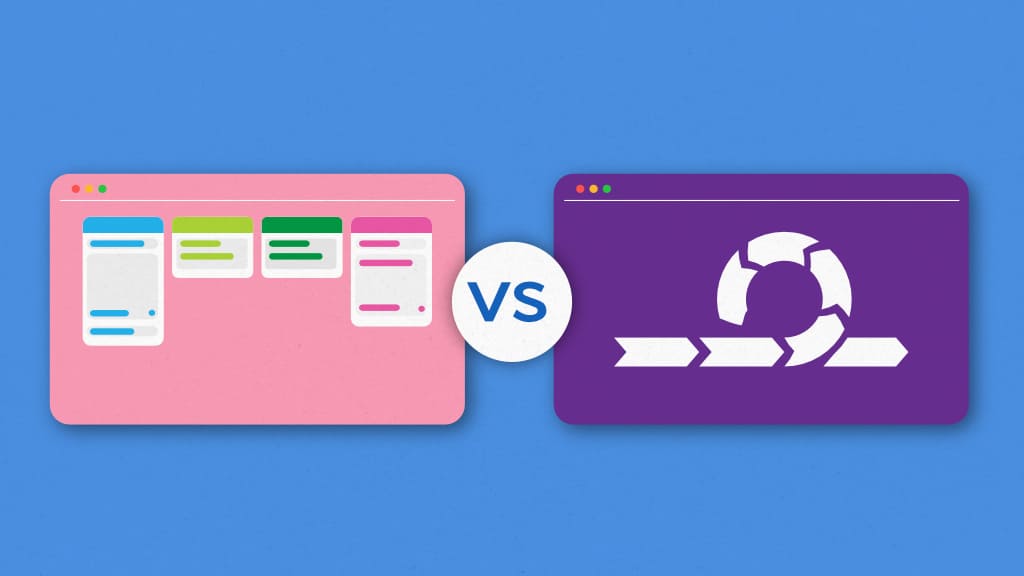Kanban vs Agile!
It is a common belief for people who consider kanban and agile to be entirely two different terminologies and compare them with each other as fierce rivals.
However, the basic truth here is that Agile is the parent umbrella, and Kanban is actually an integral part of Agile itself.
Kanban and agile cannot be compared to each other. While agile is all about methodology, kanban is more about the practical approach of bringing agile methodology to life by incorporating changes as per our typical project requirements.
As Project managers, leaders, or in any designation in the management, we should understand that these terms add value to the functioning of the team, and thereby, comparing both these terms doesn’t effectively guarantee an enhanced outcome.
Both of them behave differently but at the same time work on more or less the same pattern!
Just as I mentioned before, agile is the parent umbrella and there are various frameworks such as scrum, Extreme Programming(XP), lean software development, and obviously kanban that are all sub-parts inside this umbrella.
In this article, I have widely explained these two methodologies in detail, before narrowing down on the differences and how they impact the overall functioning of the project team.
What is agile?
Agile is a project management methodology that focuses on iterative and incremental development, meaning that projects are broken down into smaller, more manageable tasks that are completed in short cycles.
To understand agile methodology and its needs, you must know about the waterfall methodology. Teams initially worked on this waterfall methodology that was literally air-tight and had very little space for adjustments and modifications.
This forced the need for a system that allowed changes and modifications as per the workflow. It was after the 2000s that project managers felt the need for a more flexible and comprehensive system that would fulfill the ever-changing needs of the project.
Agile software development can be illustrated as a system in which you are building a house without a blueprint. You make plans for each stage as you progress. This provides you with the ability to make quick adjustments and modifications in the house.
Similarly, software development teams using agile methodology are able to deliver projects on time, adapt to changes with ease, and improve performance on the basis of feedback.
How agile works?
As per a recent study, more than 70% work on agile methodology to generate better visibility of projects, resulting in an increase in the focus and attention of team members.
This clearly shows the wide presence of agile methodologies in business applications across the world.
Agile teams work on the following agile principles and processes.
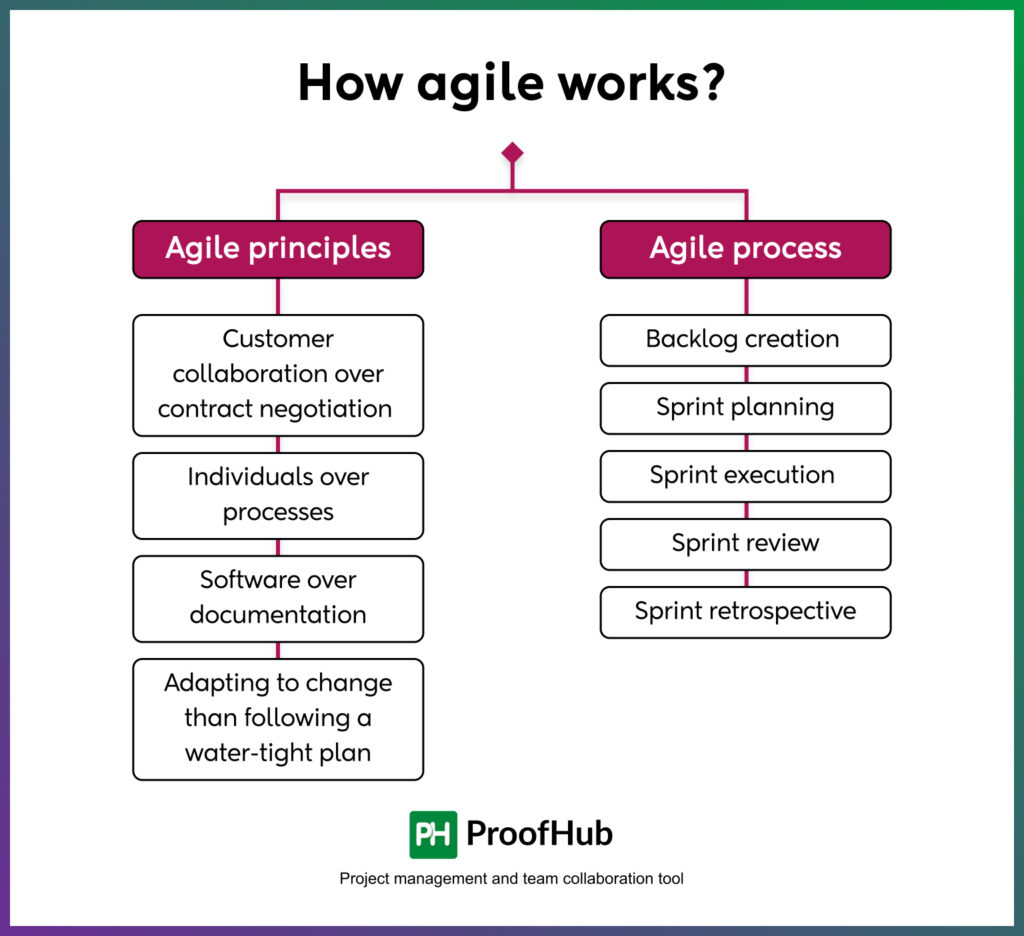
Agile principles
The set of values and guidelines that help you to follow the agile methodology of project management. You lay the foundation for customer satisfaction, and high-quality deliverables when you fulfill these agile principles.
- Customer collaboration over contract negotiation
Understanding customer requirements and focusing on fulfilling their needs effectively should be a priority. Transparent and open communication and collaboration should be considered more than negotiation.
- Individuals over processes
Although you rely on tools and software for managing tasks, it is important for you to value the contribution of team members. Understanding, valuing, and respecting people is the ‘heart’ of the agile system.
- Software over documentation
You need to focus on delivering the product (i.e. the software) instead of conveying plans and requirements. Customers want software that solves their requirements more than documents.
- Adapting to change than following a water-tight plan
You should be flexible enough to adapt to requirements and situations. Accepting change requires you to come up with new strategies that help in completing and delivering high-quality projects.
Agile process
When it comes to the agile process, the project progresses in an effectively planned, executed, and monitored process. Following are the processes that are involved in agile.
- Backlog creation
The entire list of tasks, features, and requirements is created that need to be completed on time.
- Sprint planning
A specific time slot is selected, and tasks are picked up from the backlog. The team plans to complete the task in that time.
- Sprint execution
The team works together to complete all the tasks in a particular sprint cycle. The teams have short and frequent meetings to discuss progress, plans, and challenges every day. They primarily focus on delivering an incremental product by the end of the sprint cycle.
- Sprint review
The completed product is handed over to the stakeholders. Feedback is incorporated into future sprints.
- Sprint retrospective
Basically, a review meeting to analyze and discuss what went right, areas of improvement, and actions for continuous improvement.
Level up your Project management game with these Best Agile project management tools
Benefits of agile
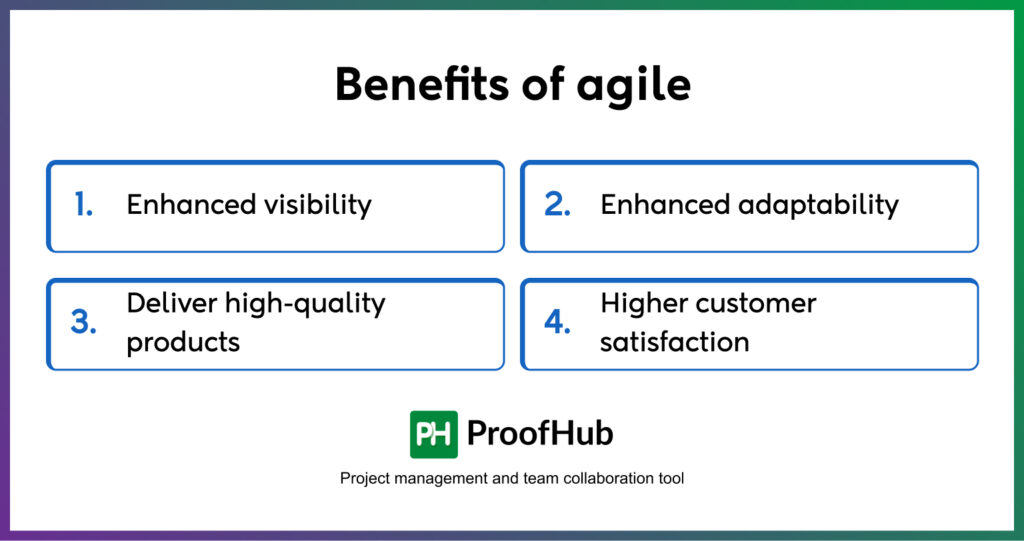
The primary benefit when it comes to agile is the adaptability and flexibility in managing projects. Agile teams are able to incorporate changes quickly and effortlessly into the workflow. The other benefits of agile include.
- Enhanced visibility
Teams working on agile have improved and enhanced visibility that will be able to forecast future events with precision. Agile principles and processes are like a cornerstone that assists you in improving visibility over time.
- Enhanced adaptability
One of the key principles of agile is “adapting to change”, so agile teams are able to effectively adapt to changing environmental conditions with ease.
Practically, adaptive and iterative working is efficient in minimizing waste generation and also helps in a continuous feedback process.
- Deliver high-quality products
As the delivery is generally in the form of small working software, agile teams have the opportunity to receive continuous feedback.
By working on this feedback, agile teams are able to improve the quality of products with every new delivery. Overall, this ensures the delivery of high-quality products.
- Higher customer satisfaction
agile teams primarily focus on ensuring high customer satisfaction. Such teams prioritize their engagement with the customer.
Because of this continuous interaction, teams are able to focus on the necessary features and push the less important requirements into ‘Backlogs’.
What is kanban?
Kanban is a powerful workflow methodology that uses board views for task lists. This helps create scalable and customized workflows that help teams deliver on a continuous basis.
Kanban is basically a subset of the agile project management process. You will be able to get a visual representation of the overall workflow in a simple way that your team members can understand with ease.
Kanban teams use kanban boards to arrange tasks in the form of cards, limit WIP in different stages, and ensure timely completion by early identification of bottlenecks.
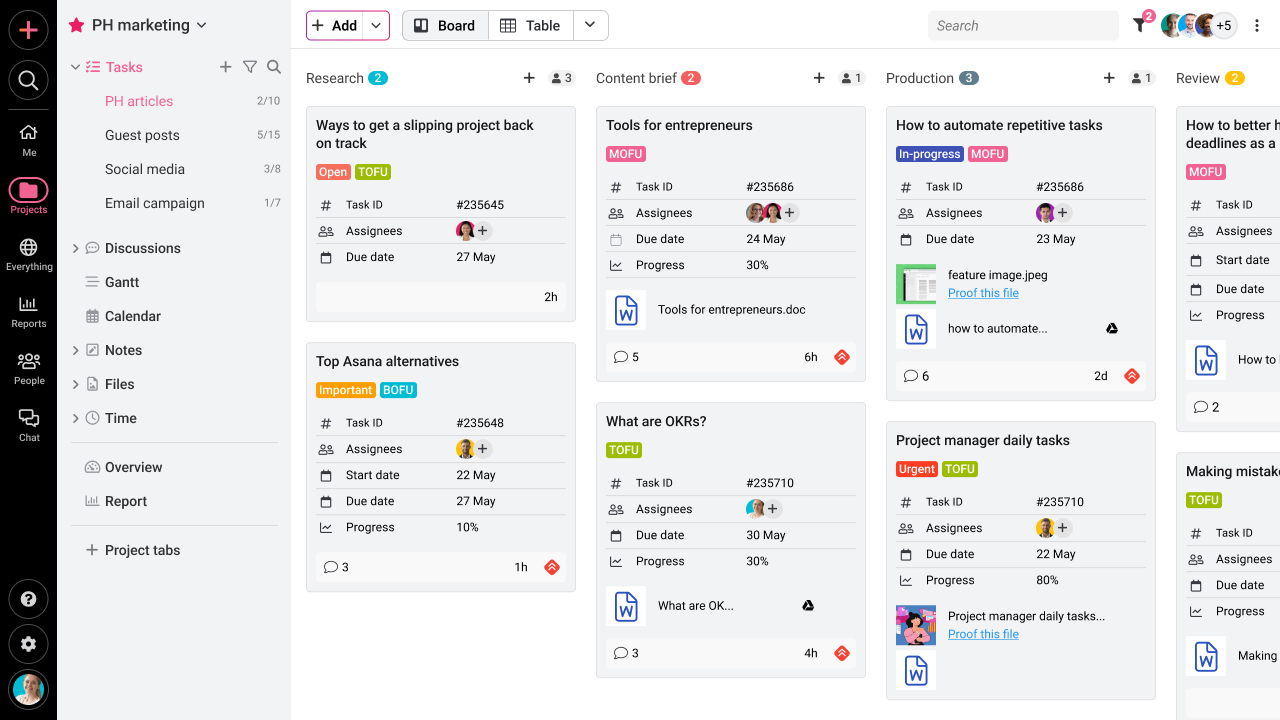
Further, kanban simplifies complex project management and helps in the smooth transition of projects across multiple teams within a single environment.
Read more – What is Kanban? Methodology, Types & Benefits Explained
How kanban works?
The kanban basically shows you 3 important things –
- The tasks that are currently in progress
- Upcoming tasks
- Completed tasks
Hence, any new task is a card that appears on the leftmost task list of the board. As soon as you start working on that particular task, the card jumps one step to the right, and so on. By the time you complete the task, the card will be on the rightmost task list.
Kanban works on the following principles and processes that we will discuss in the upcoming sections.
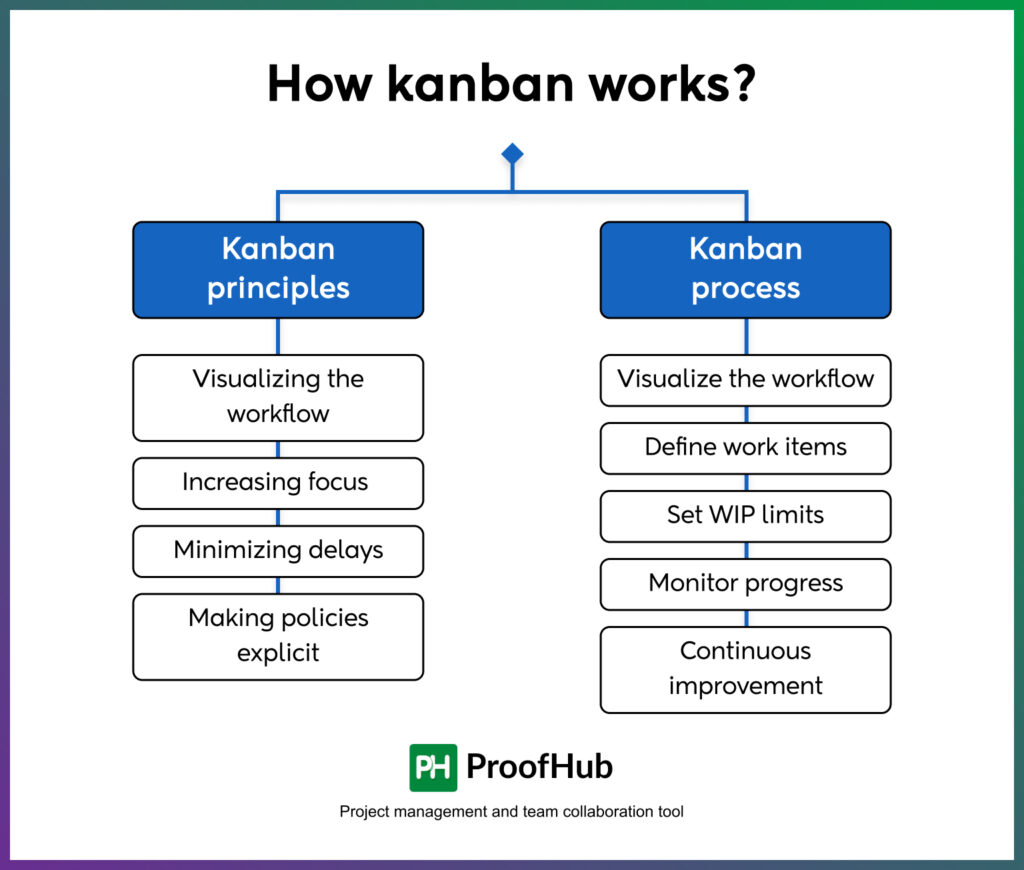
Kanban principles
Basically, kanban-based project management has the following key principles –
- Visualizing the workflow
The primary emphasis is on visualizing the entire workflow. This is the reason why we have separate columns to sort things. Different stages are denoted in the form of columns. This provides a simple understanding of the task progression to every member.
Intrigued to see kanban boards in action? Visit: Online Kanban Board Software: ProofHub
- Increasing focus
Each column has a Work-in-progress (WIP) limit as well. These limits ensure that members work with better focus and solve any potential roadblocks before it actually becomes an issue. Also, team members are encouraged to avoid multitasking and complete tasks on time.
- Minimizing delays
Kanban ensures a smooth flow of projects from start to finish. This is done by reducing cycle times, eliminating wait times, and identifying bottlenecks early. Teams also use time tracking to keep track of the time spent on various tasks and use such data for continuous improvement.
- Making policies explicit
Kanban project management methodology encourages teams to make their policies explicit. This will help in consistent and predictable behavior, which will help the team work efficiently and make informed decisions.
Kanban process
Kanban project management has certain processes that ensure a smooth flow of the project.
- Visualize the workflow
Create separate columns for different categories. The three most common stages include “to-do”, in-progress” and “done”.
- Define work items
Breaking projects into tasks, tasks into subtasks, and further into small chunks helps in quickly completing tasks on time.
- Set WIP limits
This is primarily to prevent your team members from overworking. These limits ensure teams finish tasks before starting new ones.
- Monitor progress
The kanban cards move across the board, indicating the status of each task. This helps in keeping all the collaborators and stakeholders up-to-date on the project’s progression.
- Continuous improvement
Regular review meetings help identify areas for continuous improvement. This includes analyzing performance, effective resource distribution, and optimizing workflow for future projects.
Boost your team’s productivity with these Best Kanban apps to improve workflows
Benefits of Kanban
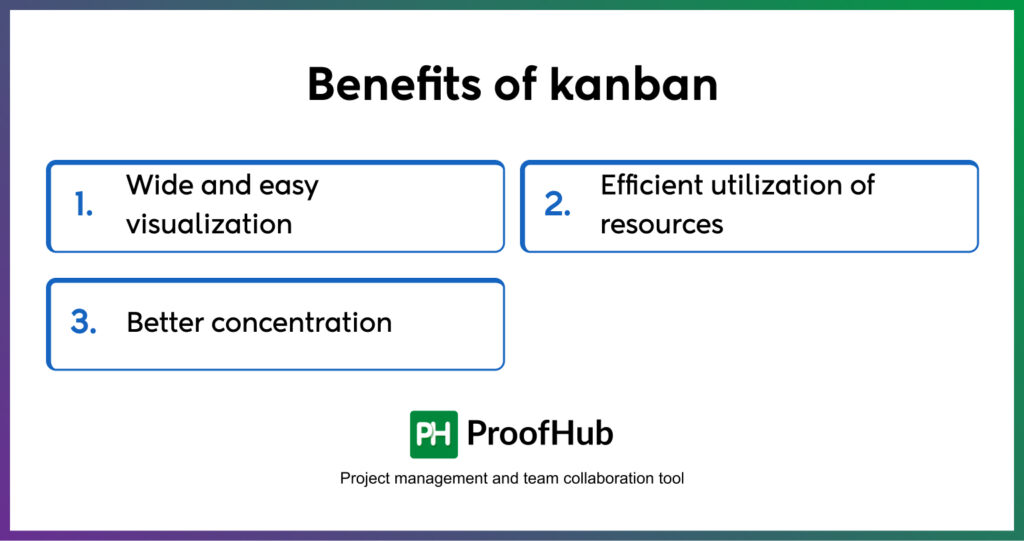
When it comes to the benefits of kanban, it is more or less similar to Agile because kanban is basically a subset of agile that works on a similar outline. The other benefits of kanban.
- Wide and easy visualization
When it comes to kanban, the entire team is easily aware of the progression of various tasks. Further, the different stages help in quickly identifying the stage of multiple tasks and make it simple for team members to work on their tasks.
- Efficient utilization of resources
With wide visibility, you will be able to use your resources effectively. This helps you to complete projects on time and deliver high-quality results without actually needing additional resources to jump in and do this work for you.
- Better concentration
Team members are able to focus on critical tasks with minimum multi-tasking. Although multitasking helps in completing projects quickly, there is always a lapse in quality. This can be addressed with effective WIP that will limit the number of tasks team members can work on at any particular given time.
Kanban vs. agile – the key differences in functionalities
The key difference between Kanban and Agile is that Kanban emphasizes continuous workflow management and task visualization, making it flexible and adaptable to changes. While, Agile is a broader project management philosophy that encompasses various methodologies, including Scrum and Kanban, focused on iterative development.
Now that we have discussed these two terms independently let’s now go one step further to understand the difference on the basis of different functionalities and applications.
1. Approach
Kanban focuses on continuous improvements and flow. The methodology focuses on visualizing work, limiting WIP, and optimizing the flow of tasks. You can easily identify bottlenecks early and solve them.
Agile methodology focuses on flexibility and iterative development. Agile teams have an iterative and customer-focused approach. The methodology focuses on supportive teamwork and continuous improvement in performance. This ensures the timely delivery of quality working software.
2. Tracking and monitoring
Kanban boards visualize tasks in the form of sticky notes. Each task moves across the board as the project progresses. This visual representation helps your team members understand the flow of work easily.
Agile uses burndown charts and task boards. These charts display the remaining time for any project with respect to the pending tasks. This helps team members to monitor progress effectively and work effectively towards managing tight deadlines.
3. Roles
Kanban emphasizes on self-organizing teams and members that make independent decisions. The success of the Kanban team is generally shared among team members, as they are the ones who contribute with expertise and insights for successful project completion.
Agile defines specific roles within the team. These roles include the product owner, scrum master, and development team. The product owner represents the vision of the project, the scrum master facilitates the process, and the development team delivers the project. Together, they are responsible for achieving the overall goal of the team.
4. Managing change
Kanban has enough flexibility to adjust to unexpected changes and priorities. There is a continuous feedback loop in kanban in order to incorporate necessities that ensure the project remains on track for timely completion.
Agile teams receive frequent feedback for iterative and incremental approaches. This methodology understands the requirements of team changes as the project progresses and the customer needs may vary over time.
5. Performance measurement
Kanban focuses on cycle time and lead time. The cycle time refers to the time it takes for the task to move from start to completion, while the lead time is a broader category. This starts from the initiation of the task till its completion.
Agile methodology generally uses burndown charts and velocity graphs to measure performance. Velocity graphs calculate the work completed by the team in a particular sprint. The burndown charts help in monitoring the time left for completing tasks. This helps in effectively analyzing performance and making data-driven decisions.
Is kanban a part of agile?
It is a widespread misconception that the agile methodology came into existence in 2001 after the Agile Manifesto was released.
However, iterative methodology for software development has been in use since the 1970s. Even popular methodologies such as Scrum and XP(Extreme Programming) were already in use by various teams.
Kanban is a subset of agile that focuses on effective planning, timely delivery, and continuous improvement. In simple words, kanban is an effective working example of agile.
Kanban was defined as a methodology that implemented agile with typical tweaks as per your respective project and came into existence after 2007.
Agile methodology focuses on work completed in short sprints, i.e., continuous delivery. This method is highly flexible when it comes to unpredictable project changes.
Agile methodology & types
In the previous section, we discussed that kanban is a subset of agile, and agile itself came into existence in 2001, while other methodologies worked on similar principles.
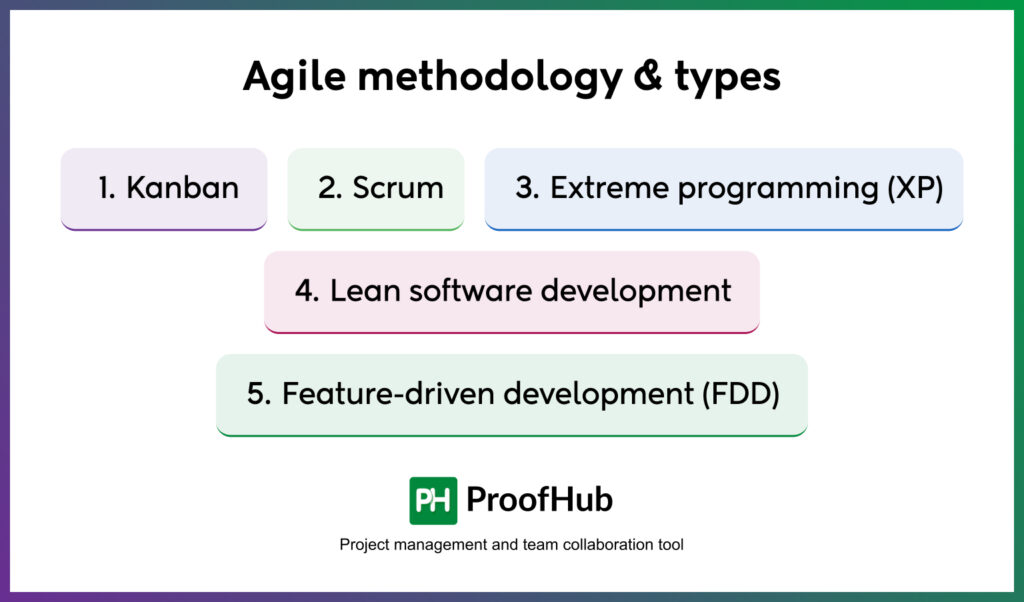
So now let’s briefly discuss the other agile methodologies.
- Kanban
As we have been discussing right from the start of this article, kanban uses boards as visual signals to understand the progression of various tasks. kanban board primarily consists of three columns – “Upcoming”, in-progress” and “done”, and the cards generally move from left to right of the board.
- Scrum
Scrum works on the agile framework but primarily focuses on working in the form of small cycles. These individual cycles are known as sprint cycles. Teams working on scrum sprint cycles generally try to deliver working software at the end of every sprint cycle.
- Extreme programming (XP)
Just as the name suggests, this methodology focuses on working in environments with extreme changes in the working plan. Teams working on XP methodology work on changes in software even when the development has reached an advanced stage.
- Lean software development
The Lean software development methodology follows a set of 7 principles. The prime focus is on “deferred commitment” – which means teams first focus on understanding the whole project before coming up with ideas and other business requirements.
Additionally, the teams focus on removing anything that does not add value to the team.
- Feature-driven development (FDD)
This is a customer-centric approach for iterative and incremental development of working software. FDD primarily aims to deliver working software to clients consistently, thereby ensuring that large project teams are able to deliver projects on time.
Applying agile methodology: Scrum vs kanban
Scrum is an agile framework that focuses on completing tasks in short development sprint cycles. Scrum teams generally adapt to the entire process and build a team that is committed to continuous delivery.
There are a few key differences that set these two agile frameworks apart. Scrum contains a list of “rules” that define work progression. However, kanban provides you with a visual representation of the tasks.
Scrum runs on sprint cycles with a number of finished tasks at the end of each cycle. On the other hand, kanban workflow does not have such a rigid time frame. Additionally, Kanban has different work stages, which does not make it mandatory to finish tasks at the end of every stage.
Explore in detail – Kanban vs Scrum: Which one is better to use
When to use scrum vs. kanban?
If you are given the option to choose between scrum and kanban, the decision is purely subjective.
You cannot define which teams should specifically use Scrum and Kanban on any prerequisites. The choice primarily depends on the type of project and the team members working on that particular project.
Suppose you are primarily aiming to deliver a large project on time. In that case, scrum will help you to manage the project in multiple manageable chunks by setting up deadlines and goals accordingly.
If your project is already small, or your team is mostly working on bug fixes and enhancement requests, kanban is the best bet for such a team. You would also be able to react quickly to changes in real-time.
Streamline your work with ProofHub
Now that we have theoretically analyzed the differences between kanban and agile project management methodologies, we will now have a look at how ProofHub brings this to practicality.
ProofHub is a versatile project management and team collaboration software that helps team members effectively plan, create customized kanban workflow, and work on projects with Agility.
The key functionalities brought to you are as follows:
- Defining roles and access
Agile teams generally face issues pertaining to individual roles and responsibilities.
ProofHub lets you clearly define roles and access permissions for various team members. This helps agile teams to function with ease, as different members are aware of their exact responsibilities, and are able to see what they have to.
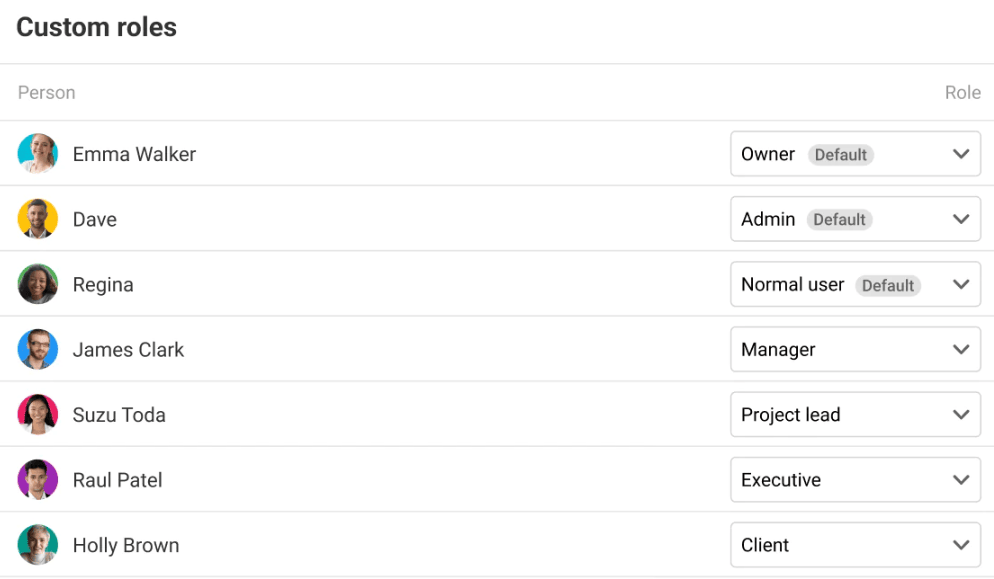
- Custom field reporting
With custom reports, you can visualize progression, view detailed insights into performance, and forecast resource requirements effectively.
Further, incorporating customer feedback after every stage will improve the overall quality of the end product.
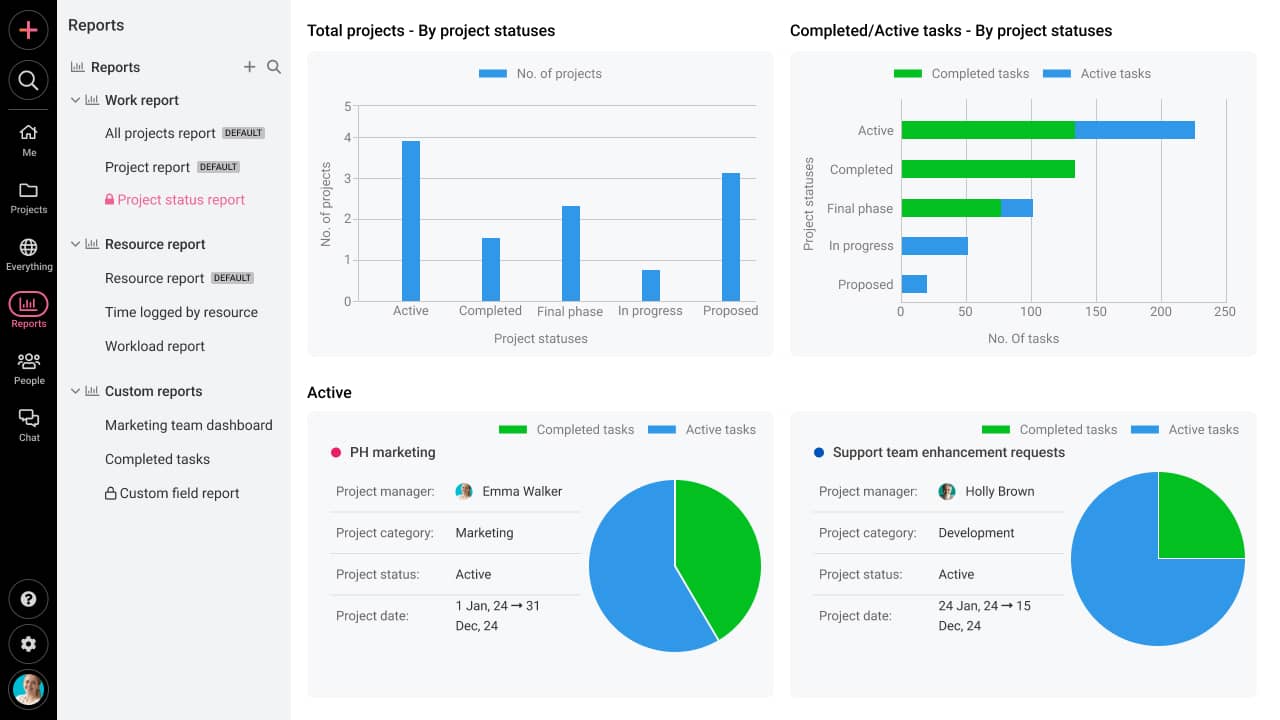
- Customizable workflow
Kanban boards with customizable templates help you design a workflow entirely as per your requirements.
Further, these boards will help you to track progress effectively, and provide a transparent view of task progression to the entire team.

Read More- Kanban board examples for beginners
Bottom Line
Kanban and agile are project management methodologies that add value to project management. While agile methodology helps when the final goal is not set, kanban minimizes the waste of resources.
Ultimately, the best project management framework for your team will depend on the specific needs of your project.
Speaking from my experience, if you need a framework that is flexible and adaptable, then agile is a good choice, and kanban is a mechanism to implement that methodology with your ‘typical tweaks’.
FAQs
Is kanban considered agile?
Kanban is often considered a subset of agile project management, but it is not technically an agile framework. agile frameworks are characterized by their iterative and incremental development process, while kanban is a more lightweight framework that focuses on visualizing work and limiting work-in-progress.
However, kanban can be used in conjunction with agile frameworks to provide a more visual and flexible approach to project management. For example, a team using the scrum framework might use a kanban board to visualize their work and track their progress.
Are scrum and kanban both agile?
Yes, both scrum and kanban are agile methodologies used in software development for improving productivity, collaboration, and adaptability.
What are the 6 rules of kanban?
The 6 rules of kanban are as follows
- Visualize work.
- Limit work in progress.
- Manage flow.
- Make policies explicit.
- Improve collaboratively.
- Evolve experimentally.
What are the 4 values of agile?
The four values of agile are
- Individuals and interactions over processes and tools
- Working software over comprehensive documentation
- Customer collaboration over contract negotiation
- Responding to change over following a plan.
Which is better Scrum or Kanban?
Scrum and kanban are two popular project management frameworks that have different strengths and weaknesses. Scrum is a more structured framework that is well-suited for projects with well-defined requirements. Kanban is a more flexible framework that is well-suited for projects with changing requirements.
In what situations is kanban way superior to scrum?
Kanban is superior to scrum in situations where there is a need for continuous delivery, flexibility in task prioritization, and a focus on reducing bottlenecks and cycle time.
